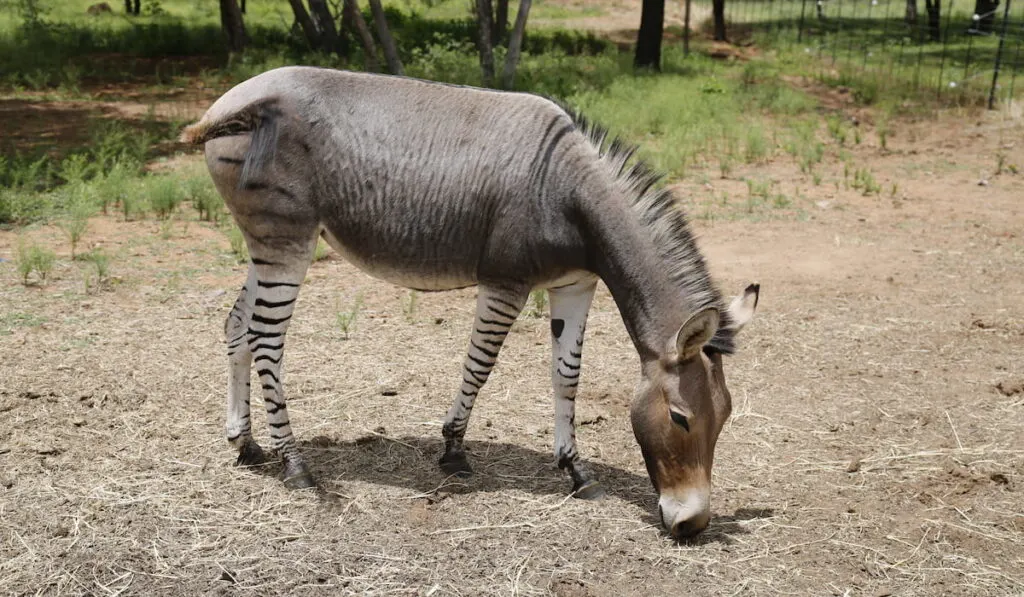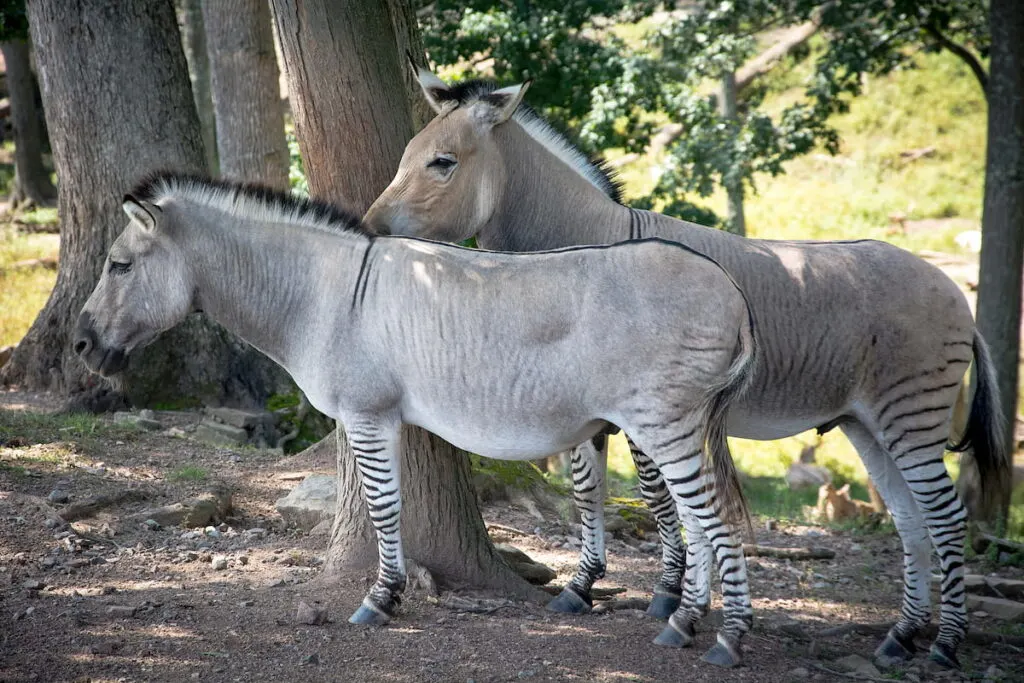Horses and zebras are similar, but are they similar enough to crossbreed?
Can a zebra be bred with a horse?
Zebras and horses can most certainly breed. For example, a zorse is what you get when you mix a mare (female horse) and a male zebra. They’re also known as zebroids, a more general term for a horse-zebra mix.
Animal breeders often experiment with breeding similar species in their care, sometimes for specific reasons, and sometimes it happens by accident. Zebra-horse hybrids may be one of the more common crossbreeds you may see.

Horses and zebras are from the same Equus family, so crossbreeding them successfully isn’t as surprising. Breeding them together is sort of like some of the recent dog breed combinations with possible hypoallergenic benefits.
The only issue is, however, that there aren’t many practical applications for breeding horses and zebra.
While horses are relatively common in the United States, zebras are typically only found in zoos because they’re not native to this continent. Many known zebroid animals are believed to be in Africa, where it’s much easier to see zebras.
Here’s some helpful information about what you get when you breed a zebra with a horse and other interesting zebroid facts.
Table of Contents
Reasons to Breed Zebras With Horses
Horse and zebra crossbreeds date back hundreds of years.
According to some sources, people first tried to breed zebras and horses to make smaller versions of horses that were easier to ride.

In addition, zebras are stronger and have more stamina than horses relative to their size, so the thinking was that crossbreeding would produce a durable animal that was easy to train and fun to ride.
Zebras are also much more disease-resistant, particularly in parts of Africa where fly-borne diseases are common. By breeding horses with zebras, farmers and other people who used horses hoped that zebroids were the answer.
Using Zebroids as Pack Animals
Zebroids are still relatively common in Africa: It’s possible to encounter them on the continent versus being very rare here in the United States.
Africans still use zebroids as pack animals.
Their strength allows them to carry a lot of weight long distances without getting tired or sick.

People also ride zebroids. Riding zebras is possible, but they aren’t as comfortable as zebroids.
When a horse is bred with a zebra, the animal takes on more shape characteristics from the horse, making it a smoother ride than a purebred zebra.
Zebroid Characteristics
So, what does a zebroid look like? What makes it different than a horse or a zebra?
Like other breeding programs, breeders aim to keep as many positive characteristics as possible and weed out any unfavorable traits in each new generation.
With zebroids, modern mixes are smaller than horses but have horse shapes to make them comfortable to ride.

In addition, they’re smaller, so they’re easier to mount or load with packs compared to a regular horse.
Zebroids are beautiful, unique animals.
Zebroids have short coats with stripes that make them stand out.
A zebroid’s coat is coarse to withstand harsher weather conditions and tends to be darker than your average zebra’s. They’re often dark brown or gray, even where they have stripes on their bodies.
Zebroids are typically flighty like their zebra relatives.
These instincts evolved from spending thousands of years avoiding African predators, so the instinct to run when threatened or shy away from uncertain situations is deeply ingrained.
Do Zebroids Have Stripes?
As far as the characteristic stripes go, zebroids vary greatly.
Many zebroids have striped heads and hindquarters. Their mid-sections look more like a horse’s, and the color and coat will depend on the father’s or mother’s.

Other times, however, you’ll see zebroids that look like a horse, but the bottom half of their legs are covered in white and black stripes like zebras. The different patterns are one of the unique things about zebroids.
Zebroids and Mules
Zebroids are similar to mules in that they are typically born sterile.
A mule, which is a mix between a horse and a donkey, cannot have offspring of its own. The same goes for zebroids.

In addition to sterile offspring, captivity is another challenge to successful zebroid breeding. Breeders have a very hard time breeding certain types of zebras in captivity.
So, despite the potential benefits, breeding zebroids isn’t common because it’s so difficult, and successful cases can’t produce future offspring.

Zebroids Are Stubborn
You’ve probably heard the phrase, “stubborn as a mule.” Well, zebroids are no different. You get many stubborn personality traits from zebras, and you also have to deal with their flight instinct.
In addition, they don’t train as easily as horses, which makes breeding them less useful.
Why Do People Breed Zebroids Today?
Today, virtually all zebroids in the United States are pets.

People crossbreed zebras with horses to see what they’ll look like when they come out.
You’ll find a lot of zebroids on homesteads or small farms that keep animals like these as pets.
Zebroids can form good bonds with you if you spend enough time around them.
The zebra part of their personality is usually very strong, so don’t expect them to be as docile or as eager to please as a good horse.
However, with time you can train your zebroid for riding and other fun activities. Of course, it all depends on how much work you’re willing to put in and the general temperament of the animal.
Final Thoughts
Hopefully, this article gives you some useful information about zebroids and why people have them today!
Resources
- https://ihearthorses.com/all-about-the-zorse-and-other-zebra-hybrids/
- https://animals.mom.com/did-humans-create-mules-3306.html
- https://www.horsefactbook.com/trivia/zebroids-can-you-ride-them/

